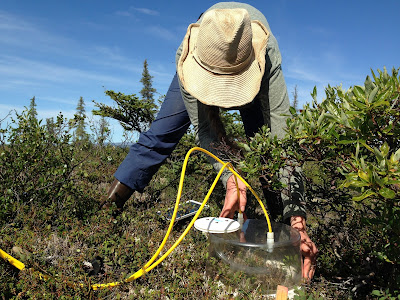Greenhouse gas emissions, including the flux of CO2
and CH4 from terrestrial ecosystems, provide an important land-atmosphere
feedback to climate. As such, the NGEE Arctic project has several tasks that target
a mechanistic understanding of the processes that control the carbon cycle.
This applies not only to our field and laboratory studies, but also to our
modeling where it is critical to properly represent the timing, rate, and
magnitude of CO2 and CH4 flux from plants, soils, and
ecosystems.
This week Ori (LBNL) and others are busy measuring trace gas
flux at locations across the landscape at our field site near Council, AK. You
may remember Ori from her work in Barrow where she has been helping with our
measurements since 2014. Using similar techniques as those perfected at Barrow,
Ori is working this week to deploy a network of chambers that will allow our
team to determine how the flux of CO2 and CH4 varies in
tussock tundra and in areas where permafrost thaw and thermokarst formation are
underway. Ori has installed PVC bases into the soil at dozens of locations
across the field site. She is using a portable gas analysis system from Los Gatos
Research to measure flux rates by first placing a clear or opaque chamber on
the PVC bases. An air-tight seal ensures that both the increase and decrease of
CO2 and CH4 concentration can be measured, from which rates
of ecosystem gas exchange can be estimated.
Field-scale measurements of CO2 and CH4
flux will be important for quantifying whether tundra ecosystems are a source
or sink for carbon. More importantly these data, and the knowledge derived from
them, will guide more mechanistic studies under controlled conditions in the
laboratory and validate how those mechanisms are represented in models. The
results that Ori and others gain this week will also help us prepare for more
intensive measurements next year.


